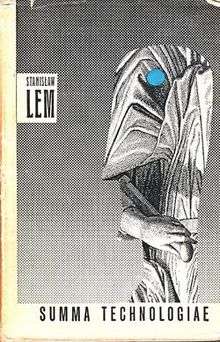Summa Technologiae
 First edition | |
| Author | Stanisław Lem |
|---|---|
| Cover artist | Daniel Mróz |
| Country | Poland |
| Language | Polish |
| Publisher | Wydawnictwo Literackie |
Publication date | 1964 |
Published in English | 2013 |
| Pages | 448 |
| ISBN | 978-0816675760 |
Summa Technologiae (the title is in Latin, meaning "Sum of Technology" in English) is a 1964 (1967 - second edition) book by Polish author Stanisław Lem. Summa is one of the first collections of philosophical essays by Lem. The book exhibits depth of insight and irony usual for Lem's creations. The name is an allusion to Summa Theologiae by Thomas Aquinas and to Summa Theologiae by Albertus Magnus.
Paraphrasing the author, the book tries to "examine the thorns of roses that have not flowered yet" - in other words, to deal with problems of the remote (and in some cases, not so remote) future. The primary question Lem treats in the book is that of civilization in the absence of limitations, both technological and material. He also looks at moral-ethical and philosophical consequences of future technologies.
Despite its age and a number of inaccuracies in specific domains (e.g., mathematics, biology, sociology), the book has lost no momentum in the past years. Surprising as it can be, some issues discussed in the book sound more contemporary nowadays than 40 years ago. Among the themes that Lem discusses in the book and that were completely in the realm of science fiction then, but are gaining importance today, are virtual reality, nanotechnology, artificial intelligence and technological singularity.
The book was originally published in Polish; translations into German, Hungarian and Russian[1] appeared by the 1970s, to be followed by Czech later on. The first full English translation of the book appeared in 2013, by Joanna Zylinska.[2] Chapter I "Dilemmas" and fragments of chapters II "Two Evolutions", IV "Intellectronics" and VI "Pasquil on the Evolution" had earlier been translated by Frank Prengel.
Contents
The book has 8 chapters, each dealing with far-fetched implications of a certain concept:
- 1. Dilemmas
- Lem starts by presenting his views on future prognostication and motivations in writing the book.
- 2. Two Evolutions
- This chapter considers similarities between several evolutions: biological, technological and social.
- 3. Space Civilizations
- An overview of contemporary (to the book) SETI efforts and theories is given, with their criticism.
- 4. Intellectronics
- A word coined by Lem to speculate on the field that is known today as artificial intelligence: The day will come when machine intelligence will rival or surpass the human one. Moreover, problems facing humankind may surpass the intellectual abilities of flesh and blood researchers. What shall we expect (or fear) in this conception of the future?
- 5. Prolegomena to Omnipotence
- Technological evolution gives us more and more abilities—in fact, sometime in the future we should be able to do everything at all! Or maybe not?
- 6. Phantomology
- Another term invented by Lem for what is known now as virtual reality. Human perception is limited by biology—so maybe we can bypass the real omnipotence in favor of an imitated one? Even in this case, Lem finds many surprising problems.
- 7. Creation of the Worlds
- May it be that instead of painstaking research we can "grow" new information from available information in an automatic way? Starting with this question Lem evolves the concept to the creation of whole new Universes, including (as a special treat) the construction of a heaven/hell/afterlife enabled one.
- 8. Pasquinade on Evolution
- Biological evolution did a rather lousy job designing humans and other animals. Can engineers do better?
Editions
- English
- Lem, Stanisław (2013). Summa technologiae. Minneapolis: University of Minnesota Press. ISBN 0816675767.
See also
- Science Fiction and Futurology, another Lem's book on the topic
References
- ↑ Russian translation of second edition: Mir , 1968, USSR, "Сумма Технологии" (transliteration: Summa Technologii, translation: Sum of Technology).
- ↑ Stanislaw Lem, "Summa Technologiae", translated by Joanna Zylinska, University of Minnesota Press, Minneapolis-London, 2013, ISBN 978-0816675760.
External links
- Partial translation into English (by Dr. Frank Prengel) at the Wayback Machine (archived October 12, 2004)
- Lem's short description of the book, in English
- The rise of data and the death of politics (2014-07-19), Evgeny Morozov, TheGuardian.